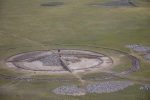 Archaeologists have discovered more than 3,000 gold ornaments in an ancient burial ground in Kazakhstan. The objects were found in a tumulus in the Eleke Sazy plateau of the Tarbagatai Mountains in eastern Kazakhstan, a site known for its 200 burial mounds of the Saka culture dating to the 8th-7th centuries B.C.
Archaeologists have discovered more than 3,000 gold ornaments in an ancient burial ground in Kazakhstan. The objects were found in a tumulus in the Eleke Sazy plateau of the Tarbagatai Mountains in eastern Kazakhstan, a site known for its 200 burial mounds of the Saka culture dating to the 8th-7th centuries B.C.
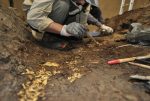 The Saka culture, a nomadic people who inhabited the Eurasian Steppe, areas of modern-day Russia, Ukraine and Kazakhstan, in the late Bronze Age and early Iron Age. The Saki were not purely nomadic. Some subgroups founded permanent settlements with large burial grounds, planted crops and mined metals. Their processing of those metals was highly sophisticated, allowing them to produce meticulously constructed jewelry and other artifacts which they traded to neighboring populations on the steppes. They also buried large quantities of them with their leaders.
The Saka culture, a nomadic people who inhabited the Eurasian Steppe, areas of modern-day Russia, Ukraine and Kazakhstan, in the late Bronze Age and early Iron Age. The Saki were not purely nomadic. Some subgroups founded permanent settlements with large burial grounds, planted crops and mined metals. Their processing of those metals was highly sophisticated, allowing them to produce meticulously constructed jewelry and other artifacts which they traded to neighboring populations on the steppes. They also buried large quantities of them with their leaders.
The artifacts unearthed in the grave are exceptional examples of Saka goldsmithing.
Among the finds are earrings in the shape of bells, gold plates with rivets, plaques, chains, and a necklace with precious stones.
Gold beads decorating clothes were made with the use of sophisticated micro-soldering techniques, indicating an exceptional level of development jewellery-making skills for the period.
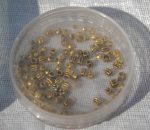 There were also gold horse fittings, spearheads and chains. Archaeologists believe the combination of jewelry and weaponry indicates the occupants of the tomb were a husband and wife couple, either rulers or at least high-ranking elite of Saka society. They can’t be sure because they haven’t even gotten to the graves yet. This immense amount of treasure was found in the excavation of the burial mound. There is likely more to be found when they reach the actual interrals.
There were also gold horse fittings, spearheads and chains. Archaeologists believe the combination of jewelry and weaponry indicates the occupants of the tomb were a husband and wife couple, either rulers or at least high-ranking elite of Saka society. They can’t be sure because they haven’t even gotten to the graves yet. This immense amount of treasure was found in the excavation of the burial mound. There is likely more to be found when they reach the actual interrals.
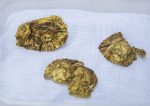 Such a rich find made after two years of excavations at the site extends hope that there are other graves of similar importance still be unearthed among the 200 known. It’s likely that the burials were plundered on a wide scale in antiquity, however, so discovering another haul of this magnitude is far from a sure thing.
Such a rich find made after two years of excavations at the site extends hope that there are other graves of similar importance still be unearthed among the 200 known. It’s likely that the burials were plundered on a wide scale in antiquity, however, so discovering another haul of this magnitude is far from a sure thing.
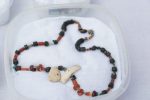 The treasures from the burial mound will be cleaned and conserved before going on display in September during the annual international archaeological conference Altai, the Golden Cradle of the Turkic World.
The treasures from the burial mound will be cleaned and conserved before going on display in September during the annual international archaeological conference Altai, the Golden Cradle of the Turkic World.
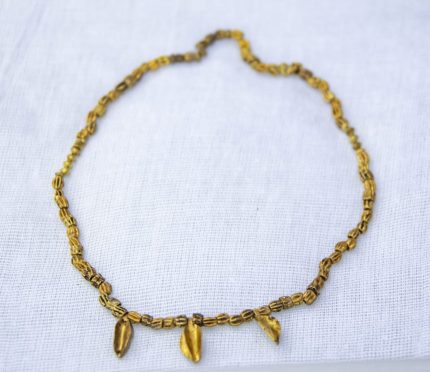
Kazakhstan, eh? – That ‘gold bead necklace’ seems to be modelled after different plant seeds. Only a few, i.e. those ‘berries’, might be ‘ephedra distachya’, the pendants look almost similar to cardamom (even if I could not tell how that would fit in here), many of the smaller ones look similar to parsley seeds, and I have no idea how Herodotus’ hemp seed is supposed to look like.
‘Ephedra distachya’ is used to relieve acute muscular and rheumatic pains , as a stimulant, and in the cardio tonics in Ayurveda. It is sometimes identified with the legendary drug soma, as described in the Avesta and the Rig Veda, the respective ancient sacred texts of the Zoroastrian and Hindu faiths. Ephedrine, an alkaloid, is obtained from its dried branches and is used as a stimulant, often to control asthma.
Herodotus lets us know: “..when their king has died, they make a large square excavation in the earth; and when they have made this ready, they take up the corpse, the body being covered over with wax and the belly ripped up and cleansed, and then sewn together again, after it has been filled with kyperos cut up and spices and parsley-seed and anise”.
Any botanists around here? Those arrow heads from the linked article, by the way, look as if they could inflict serious harm :ohnoes:
What about number ’10’ in dried up form, i.e. ‘Kannabios’ instead of cardamom?
“The Scythians then take the seed of this hemp and creep under the felt coverings, and then they throw the seed upon the stones which have been heated red-hot: and it burns like incense and produces a vapour so think that no vapour-bath in Hellas would surpass it: and the Scythians being delighted with the vapour-bath howl like wolves.”
“ταύτης ὦν οἱ Σκύθαι τῆς καννάβιος τὸ σπέρμα ἐπεὰν λάβωσι, ὑποδύνουσι ὑπὸ τοὺς πίλους, καὶ ἔπειτα ἐπιβάλλουσι τὸ σπέρμα ἐπὶ τοὺς διαφανέας λίθους τῷ πυρί: τὸ δὲ θυμιᾶται ἐπιβαλλόμενον καὶ ἀτμίδα παρέχεται τοσαύτην ὥστε Ἑλληνικὴ οὐδεμία ἄν μιν πυρίη ἀποκρατήσειε. οἱ δὲ Σκύθαι ἀγάμενοι τῇ πυρίῃ ὠρύονται.”
I would guess that the actual arrowheads are bronze. The gold decoration on the sockets is cool and probably indicates a ceremonial purpose. I wouldn’t think that they are iron because of the lack of rust. Even in that semi-arid climate there would be enough soil moisture to cause iron to oxidize.
Very cool gold find.. I wish they found coins from the saka culture. They would hold an extremely high premium for them being so rare!!
Dear Rocco,
The date of this find would be a little early for any coins. The earliest known coins date to about 600BC in Lydia in Asia Minor (Turkey).